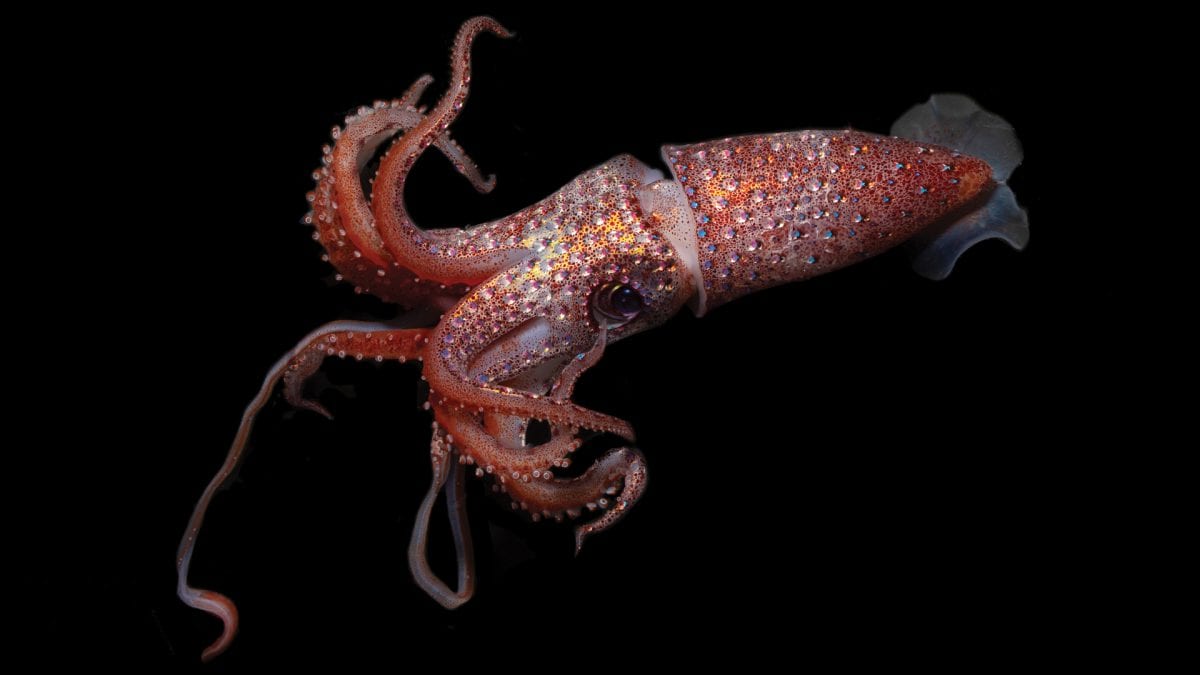Woods Hole Oceanographic Institution Wants Everyone to “Keep it Weird”
 A bejeweled beauty is a Strawberry Squid from the Ocean Twilight Zone. (Photo by Paul Caiger, © Woods Hole Oceanographic Institution)
A bejeweled beauty is a Strawberry Squid from the Ocean Twilight Zone. (Photo by Paul Caiger, © Woods Hole Oceanographic Institution) May 27, 2021
Campaign raises awareness of the ocean twilight zone by celebrating the “weird” in all of us
Woods Hole, Mass. (May 27, 2021) — Woods Hole Oceanographic Institution (WHOI) wants to keep the ocean twilight zone weird. Known for its rigorous science and advanced engineering, the usually serious WHOI today launched a tongue-in-cheek campaign to draw attention to one of the least understood, but most important regions of the ocean.
The twilight zone, or mesopelagic, is a globe-spanning layer of the ocean just beyond the reach of sunlight that is home to a vast number and diversity of creatures. Many of these inhabitants of the depths appear strange at first glance, but they are uniquely adapted to life in their environment.
“The ocean twilight zone plays a critical role in the health of our planet,” said Samuel Harp, WHOI’s Vice President for Advancement and Chief Marketing Officer. “Yet almost nobody has heard of it, and even fewer will ever see it with their own eyes. So how can we make people care what happens there?”
The answer, according to Harp, is to help people relate to the weird and wonderful characteristics that help these creatures survive, and thrive, in the twilight zone. Creatures like the fangtooth, which is known for having the largest tooth-to-body-size ratio in the animal kingdom. There’s also the angler fish. When a male angler fish finds a mate, he latches onto her with his sharp teeth, only to find his entire body slowly absorbed into the female’s body until only his reproductive organs remain. Or the popular, bioluminescent strawberry squid, which has two distinct eyes, one for looking up toward the surface and the other to peer down into the darkness. The internet fact-checking website Snopes reported that the strawberry squid does in fact exist, despite its otherworldly appearance.
“All of us know what it feels like when someone calls us weird,” said Heidi Sosik, science lead of WHOI’s Ocean Twilight Zone Project, funded by the Audacious Project at TED. “Kids as young as five already understand that in our society, being weird is often viewed as a bad thing. We want to turn that idea on its head and show that weird is what drives innovation and creativity and is something that should be celebrated. We see the weird creatures of ocean twilight as perfect examples of what makes weird, wonderful in all of us, as well."
Researchers believe that the twilight zone is home to more life than all the world’s fisheries combined. One twilight zone denizen, the bristle mouth fish, is thought to be the most numerous vertebrate on Earth, with hundreds of trillions swimming in the twilight zone. The twilight zone also plays host to the largest animal migration on earth, one that happens twice each day as vast numbers of its inhabitants’ journey to surface waters to feed every night, and then return to the darkness and relative safety of the depths during the day.
In doing so, they provide a key critical link in the ocean’s food web that helps maintain a healthy ocean and that supports many commercially important surface species. Life in the twilight zone also plays a critical role in regulating climate by transporting carbon from surface waters to the deep ocean, where it can remain sequestered for thousands of years.
Underpinning this lighthearted campaign is a serious message: Humanity has encountered pristine ecosystems before—and we have a near perfect record of exploiting and altering them, often irrevocably, before we truly understand and appreciate their value. For the twilight zone, which commercial fishers have already identified as a potentially rich resource to meet demands for aquaculture feed and for nutraceuticals such as omega-3 supplements, scientists, and engineers at WHOI think it’s not too late to do things differently. And public awareness of this remote, but vital part of the ocean is essential to this effort.
The campaign, which is aimed at kids ages 5-12 and their parents, features a website that introduces visitors to the ocean twilight zone and to WHOI’s mission to understand it. WHOI also offers educational materials suitable for middle-school classrooms. Additional events are being planned for the fall, and a children’s book is due to be released in Spring of 2022.
“The ocean twilight zone is a unique and wonderful part of our planet,” said Harp. “It deserves to be celebrated and protected, just as the things that make each of us unique and wonderful should be celebrated and protected. Everyone benefits when we work together to keep the ocean twilight zone, and ourselves, weird.”
About Woods Hole Oceanographic Institution
The Woods Hole Oceanographic Institution (WHOI) is a private, non-profit organization on Cape Cod, Massachusetts, dedicated to marine research, engineering, and higher education. Established in 1930, its primary mission is to understand the ocean and its interaction with the Earth as a whole, and to communicate an understanding of the ocean’s role in the changing global environment. WHOI’s pioneering discoveries stem from an ideal combination of science and engineering—one that has made it one of the most trusted and technically advanced leaders in basic and applied ocean research and exploration anywhere. WHOI is known for its multidisciplinary approach, superior ship operations, and unparalleled deep-sea robotics capabilities. We play a leading role in ocean observation and operate the most extensive suite of data-gathering platforms in the world. Top scientists, engineers, and students collaborate on more than 800 concurrent projects worldwide—both above and below the waves—pushing the boundaries of knowledge and possibility. For more information, please visit www.whoi.edu
Media Contact:
Suzanne Pelisson
Associate Director, Public Relations
